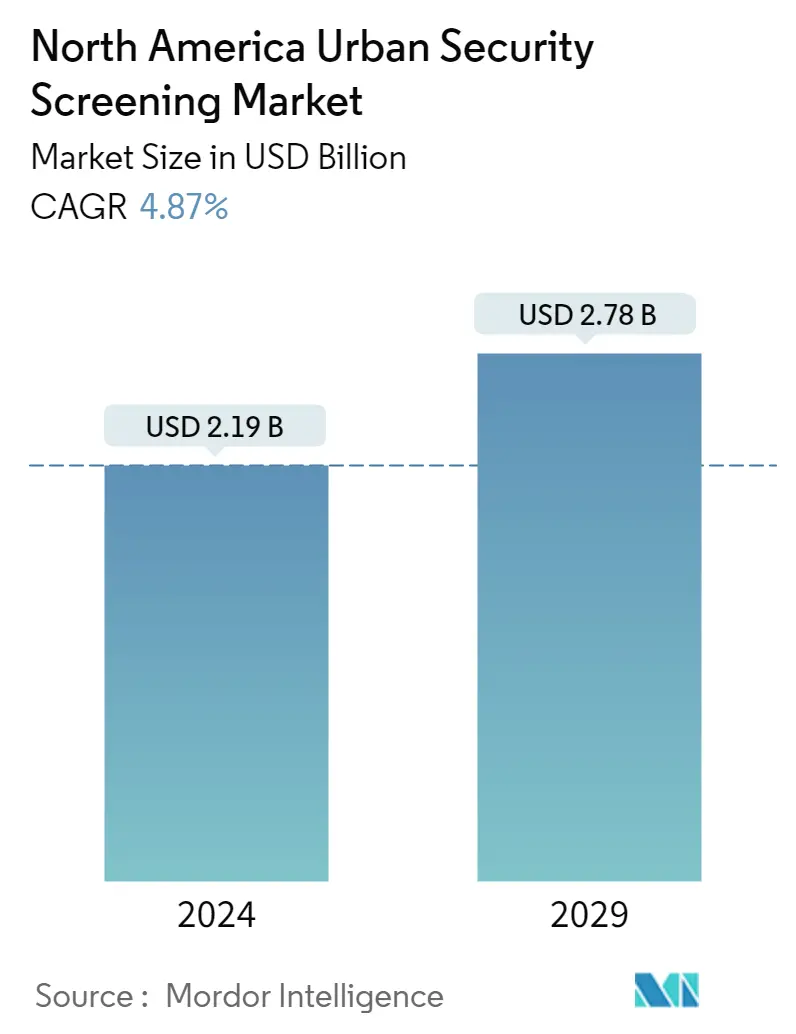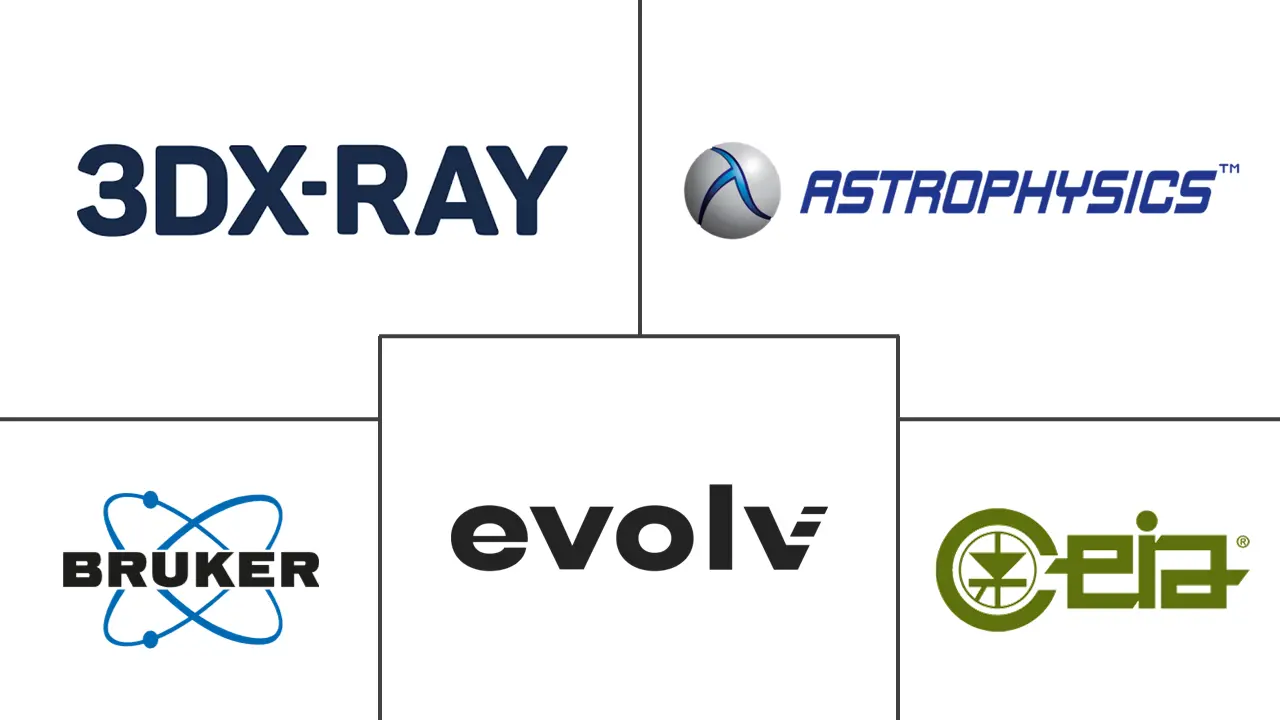Market Size of North America Urban Security Screening Industry

| Study Period | 2019 - 2029 |
| Base Year For Estimation | 2023 |
| Market Size (2024) | USD 2.19 Billion |
| Market Size (2029) | USD 2.78 Billion |
| CAGR (2024 - 2029) | 4.87 % |
| Market Concentration | Low |
Major Players
*Disclaimer: Major Players sorted in no particular order |
North America Urban Security Screening Market Analysis
The North America Urban Security Screening Market size is estimated at USD 2.19 billion in 2024, and is expected to reach USD 2.78 billion by 2029, growing at a CAGR of 4.87% during the forecast period (2024-2029).
With the increasing terror attack threats at various public and critical infrastructures, security screening is vital, especially for places like border checkpoints, government organizations, sports complexes, event stages, etc., to help mitigate the associated risk factor.
X-ray baggage scanning devices are used in high-security places like government offices, corporate establishments, and the Mass Rapid Transit System (MRTS). Optional features such as network supervisory workstation (NSW), video management, and threat image projection (TIP) are employed along with these scanners to make them more effective and efficient.
The national governments play a crucial role in developing smart cities to enhance their economic growth. They are acquiring infrastructure and passing regulations favoring the development of the security screening market across the innovative city sector. For instance, the United States House and Senate unanimously passed bipartisan legislation to maintain and improve career and technical education through creative learning to help Americans obtain skills needed for jobs.
Many companies are developing the automated security screening process, further driving the market's growth. For instance, Genetec launched a mission control solution to automate the screening process and establish effective and standardized procedures for staff and visitors to maintain proper health safety measures and minimize the risk of outbreaks.
Cost is frequently one of the first issues brought up. The initial investment in the metal detector is only a tiny portion of the overall resources required to run it. Walk-through metal detectors require ongoing maintenance in addition to an expensive initial purchase. The price of a fixed metal detector can range from USD 1,000 to USD 30,000. According to a National Institute of Justice assessment, models in the USD 4,000 to USD 5,000 price range often offer characteristics best suited for various environments.
Despite the COVID-19 pandemic, vendors in the market are progressing toward constructing data centers to cater to the strong demand from various end-user industries, further driving the market's growth. Demand for data centers in North America remains high. In March 2021, Amazon announced plans to fast-track the construction of three data centers in Loudoun County, Virginia, likely in response to the increasing demand for bandwidth due to the pandemic.
North America Urban Security Screening Industry Segmentation
Security screening is essential for public venues such as railway stations, commercial buildings, and other locations. It is commonly used to identify illegal or dangerous materials such as metal objects, firearms, and harmful chemical substances, among other things, by thorough frisking and background checks. X-rays, chemicals, and trace detection products are some techniques through which security scanning is performed in the market.
The study tracks sales revenue information of urban security screening solutions in North America. The scope of the study is limited to products such as X-ray products, millimeter wave products, metal detectors, radiation detection products, and chemicals and trace detection products across various end users that include corporate buildings, mailroom screening, warehouse and logistics, government buildings, transportation, data centers, and law enforcement. Airport security screening (passenger/baggage), border security, and port security applications are not a part of the study. The competitive landscape is to calculate the penetration of urban security screening solutions and how players involve themselves in organic and inorganic growth strategies. These companies continuously innovate their products to increase their market share and profitability. The market study is focused on the impact of the COVID-19 pandemic on the market ecosystem. The market sizes and forecasts regarding value (USD million) for all the above segments are provided.
| By Product Type | |
| X-ray Products | |
| Millimeter Wave Products | |
| Metal Detectors | |
| Radiation Detection Products | |
| Chemicals and Trace Detection Products |
| By End-user Industry | |
| Corporate Buildings | |
| Mailroom Screening | |
| Warehouse and Logistics | |
| Government Buildings | |
| Transportation | |
| Data Centers | |
| Law Enforcement |
| By Country | |
| United States | |
| Canada |
North America Urban Security Screening Market Size Summary
The North American urban security screening market is experiencing significant growth, driven by increasing security concerns and the need for enhanced safety measures in public and critical infrastructure. The market is characterized by the adoption of advanced technologies such as X-ray baggage scanning devices and automated security screening processes. These technologies are being implemented in various high-security locations, including government offices, corporate establishments, and mass transit systems, to mitigate risks associated with potential terrorist attacks. The development of smart cities and supportive government regulations are further propelling the market, as they encourage the integration of security screening solutions to ensure public safety and economic growth.
The market is also witnessing a surge in demand due to macro trends such as firearms ownership and mass shootings, which have heightened the need for effective security measures in healthcare facilities and correctional institutions. Companies are innovating and expanding their product offerings to meet the growing demand, with significant investments in advanced detection systems and digital imaging technologies. The market is fragmented, with key players like 3DX-Ray Ltd, Astrophysics Inc., and Evolv Technologies actively pursuing strategies such as product development and geographic expansion to enhance their market presence. These developments underscore the critical role of urban security screening in addressing contemporary security challenges in North America.
North America Urban Security Screening Market Size - Table of Contents
-
1. MARKET INSIGHTS
-
1.1 Market Overview
-
1.2 Value Chain Analysis
-
1.3 Industry Attractiveness - Porter's Five Forces Analysis
-
1.3.1 Threat of New Entrants
-
1.3.2 Bargaining Power of Buyers
-
1.3.3 Bargaining Power of Suppliers
-
1.3.4 Threat of Substitute Products
-
1.3.5 Intensity of Competitive Rivalry
-
-
1.4 Assessment of the Impact of COVID-19 on the Industry
-
-
2. MARKET SEGMENTATION
-
2.1 By Product Type
-
2.1.1 X-ray Products
-
2.1.2 Millimeter Wave Products
-
2.1.3 Metal Detectors
-
2.1.4 Radiation Detection Products
-
2.1.5 Chemicals and Trace Detection Products
-
-
2.2 By End-user Industry
-
2.2.1 Corporate Buildings
-
2.2.2 Mailroom Screening
-
2.2.3 Warehouse and Logistics
-
2.2.4 Government Buildings
-
2.2.5 Transportation
-
2.2.6 Data Centers
-
2.2.7 Law Enforcement
-
-
2.3 By Country
-
2.3.1 United States
-
2.3.2 Canada
-
-
North America Urban Security Screening Market Size FAQs
How big is the North America Urban Security Screening Market?
The North America Urban Security Screening Market size is expected to reach USD 2.19 billion in 2024 and grow at a CAGR of 4.87% to reach USD 2.78 billion by 2029.
What is the current North America Urban Security Screening Market size?
In 2024, the North America Urban Security Screening Market size is expected to reach USD 2.19 billion.

